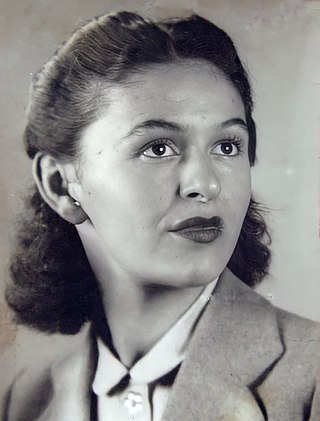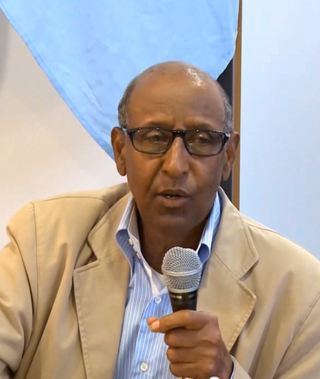
Hindi cinema, popularly known as Bollywood and formerly as Bombay cinema, refers to the film industry based in Mumbai, engaged in production of motion pictures in Hindi language. The popular term Bollywood is a portmanteau of "Bombay" and "Hollywood". The industry is a part of the larger Indian cinema, which also includes South Indian cinema and other smaller film industries.

The film industry in Albania comprises the art of films and movies made within the country or by Albanian directors abroad. Albania has had an active cinema industry since 1897 and began strong activities in 1940 after the foundation of both the "Kinostudio Shqipëria e Re" and National Center of Cinematography in Tirana.

The Somali people are a Cushitic ethnic group native to the Horn of Africa who share a common ancestry, culture and history. The East Cushitic Somali language is the shared mother tongue of ethnic Somalis, which is part of the Cushitic branch of the Afroasiatic language family, and they are predominantly Sunni Muslim. Forming one of the largest ethnic groups on the continent, they cover one of the most expansive landmasses by a single ethnic group in Africa.

Cinema of Africa covers both the history and present of the making or screening of films on the African continent, and also refers to the persons involved in this form of audiovisual culture. It dates back to the early 20th century, when film reels were the primary cinematic technology in use. During the colonial era, African life was shown only by the work of white, colonial, Western filmmakers, who depicted Africans in a negative fashion, as exotic "others". As there are more than 50 countries with audiovisual traditions, there is no one single 'African cinema'. Both historically and culturally, there are major regional differences between North African and sub-Saharan cinemas, and between the cinemas of different countries.
Asian cinema refers to the film industries and films produced in the continent of Asia. However, in countries like the United States, it is often used to refer only to the cinema of East Asia, Southeast Asia and South Asia. West Asian cinema is sometimes classified as part of Middle Eastern cinema, along with the cinema of Egypt. The cinema of Central Asia is often grouped with the Middle East or, in the past, the cinema of the Soviet Union during the Soviet Central Asia era. North Asia is dominated by Siberian Russian cinema, and is thus considered part of European cinema.

Middle Eastern cinema collectively refers to the film industries of West Asia and part of North Africa. By definition, it encompasses the film industries of Egypt, Iran, Bahrain, Iraq, Israel, Jordan, Kuwait, Lebanon, Palestine, Oman, Qatar, Saudi Arabia, Syria, United Arab Emirates, and Yemen. As such, the film industries of these countries are also part of the cinema of Asia, or in the case of Egypt, Africa.

The Egyptian film industry is today based mainly in Cairo, which is sometimes referred to as Hollywood on the Nile or Hollywood of the East, despite having its beginnings in the city of Alexandria in the early 20th century. A strong industry grew in Egypt with a high distribution rate among the Arab world, and Cairo produces around three-quarters of the Arab world's screen output. It has had a large effect on the African and Arab film industry since the early 20th century.
Abu Talha al-Sudani, was a Sudanese member of Al Qaeda terrorist organization, an explosives expert and a close aide of Osama bin Laden.

The cinema of Somalia refers to the film industry in Somalia. The earliest forms of public film display in the country were Italian newsreels of key events during the colonial period. In 1937 the film Sentinels of Bronze was produced in Ogaden Somalia, with nearly all Somali actors. Growing out of the Somali people's rich storytelling tradition, the first few feature-length Somali films and cinematic festivals emerged in the early 1960s, immediately after independence. Following the creation of the Somali Film Agency (SFA) regulatory body in 1975, the local film scene began to expand rapidly. In the 1970s and early 1980s, popular musicals known as riwaayado were the main driving force behind the Somali movie industry. Epic and period films as well as international co-productions followed suit, facilitated by the proliferation of video technology and national television networks. In the 1990s and 2000s, a new wave of more entertainment-oriented movies emerged. Referred to as Somaliwood, this upstart, youth-based cinematic movement has energized the Somali film industry and in the process introduced innovative storylines, marketing strategies and production techniques.
Arab cinema or Arabic cinema refers to the film industry of the Arab world. Most productions are from the Egyptian cinema.

Somali Americans are Americans of Somali ancestry. The first ethnic Somalis to arrive in the U.S. were sailors who came in the 1920s from British Somaliland. They were followed by students pursuing higher studies in the 1960s and 1970s, by the late 1970s through the late 1980s and early 1990s more Somalis arrived. However, it was not until the mid and late 1990s when the civil war in Somalia broke out that the majority of Somalis arrived in the United States. The Somali community in the U.S. is now among the largest in the Somali diaspora.
The Jefferson Lecture in the Humanities is an honorary lecture series established in 1972 by the National Endowment for the Humanities (NEH). According to the NEH, the Lecture is "the highest honor the federal government confers for distinguished intellectual achievement in the humanities."
The Film Foundation is a US-based non-profit organization dedicated to film preservation and the exhibition of restored and classic cinema. It was founded by director Martin Scorsese and several other leading filmmakers in 1990. The foundation raises funds and awareness for film preservation projects and creates educational programs about film. The foundation and its partners have restored more than 900 films.
The Somali Film Agency (SFA) was a film regulatory body based in Mogadishu, Somalia.
The Parching Winds of Somalia (1984) is a documentary film produced by Charles Geshekter.

Abdisalam Aato is a Somali-American film director, producer, entrepreneur and media consultant. He is the founder of Olol Films, a production company at the forefront of the Somaliwood movement within the Somali film industry.

Ali Said Hassan is a Somali film producer, director, former photojournalist and archive collector.

The Media History Digital Library (MHDL) is a non-profit, open access digital archive founded by David Pierce and directed by Eric Hoyt that compiles books, magazines, and other print materials related to the histories of film, broadcasting, and recorded sound and makes these materials accessible online for free. The MHDL both digitizes physical materials and acquires digital copies from outside libraries, archives, collectors, and other collaborators. Most of the material in its more than 2.5 million pages is in the public domain and therefore free for all to use with no restrictions.













